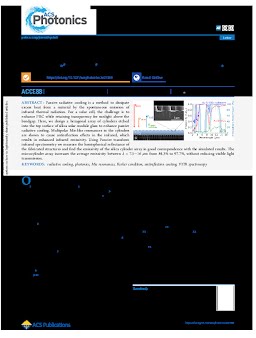2022-11-08
Passive Radiative Cooling of Silicon Solar Modules with Photonic Silica Microcylinders
Publication
Publication
ACS Photonics , Volume 9 - Issue 12 p. 3831- 3840
Passive radiative cooling is a method to dissipate excess heat from a material by the spontaneous emission of infrared thermal radiation. For a solar cell, the challenge is to enhance PRC while retaining transparency for sunlight above the bandgap. Here, we design a hexagonal array of cylinders etched into the top surface of silica solar module glass to enhance passive radiative cooling. Multipolar Mie-like resonances in the cylinders are shown to cause antireflection effects in the infrared, which results in enhanced infrared emissivity. Using Fourier transform infrared spectrometry we measure the hemispherical reflectance of the fabricated structures and find the emissivity of the silica cylinder array in good correspondence with the simulated results. The microcylinder array increases the average emissivity between λ = 7.5–16 μm from 84.3% to 97.7%, without reducing visible light transmission.
| Additional Metadata | |
|---|---|
| , , , , , | |
| ACS | |
| The Netherlands Organisation for Scientific Research (NWO) | |
| doi.org/10.1021/acsphotonics.2c01389 | |
| ACS Photonics | |
| Organisation | Photonic Materials |
|
Akerboom, E., Veeken, T., Hecker, C., van de Groep, J., & Polman, A. (2022). Passive Radiative Cooling of Silicon Solar Modules with Photonic Silica Microcylinders. ACS Photonics, 9(12), 3831–3840. doi:10.1021/acsphotonics.2c01389 |
|
